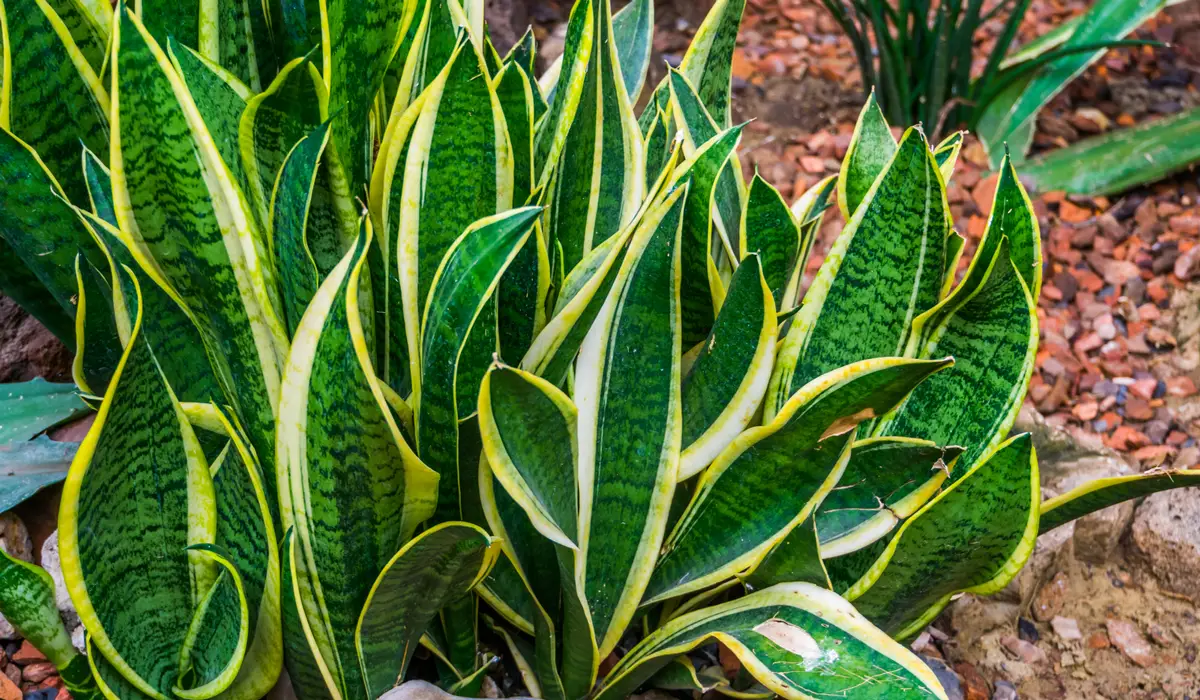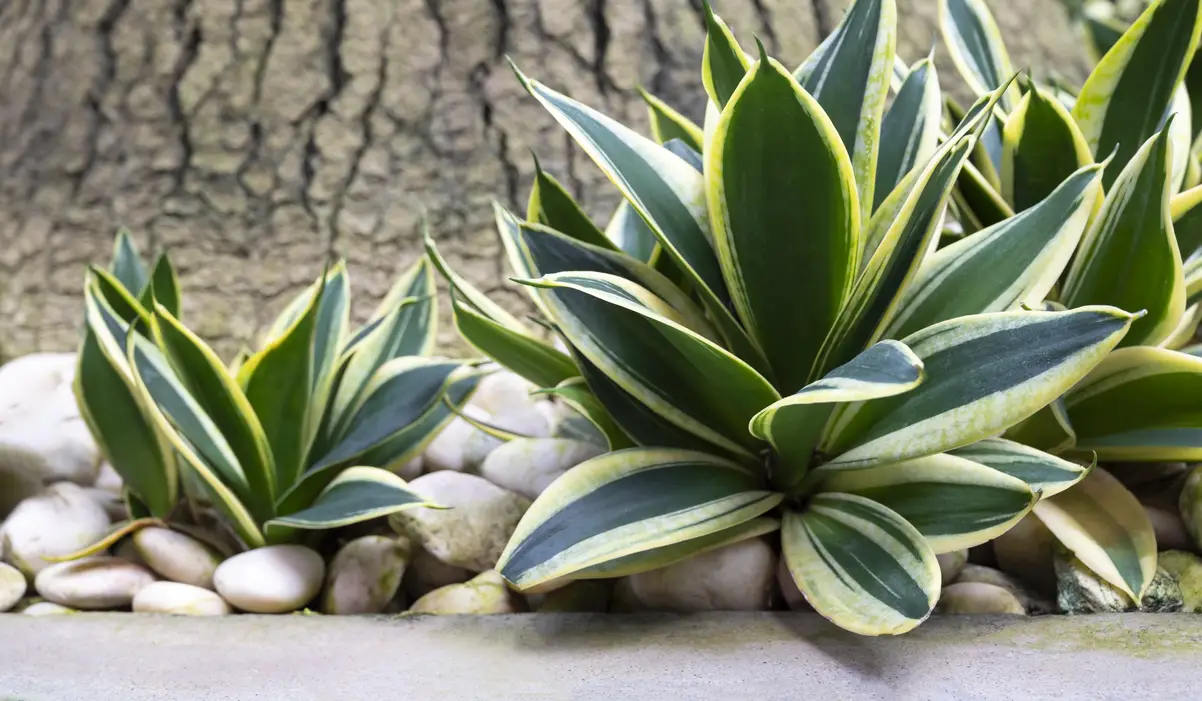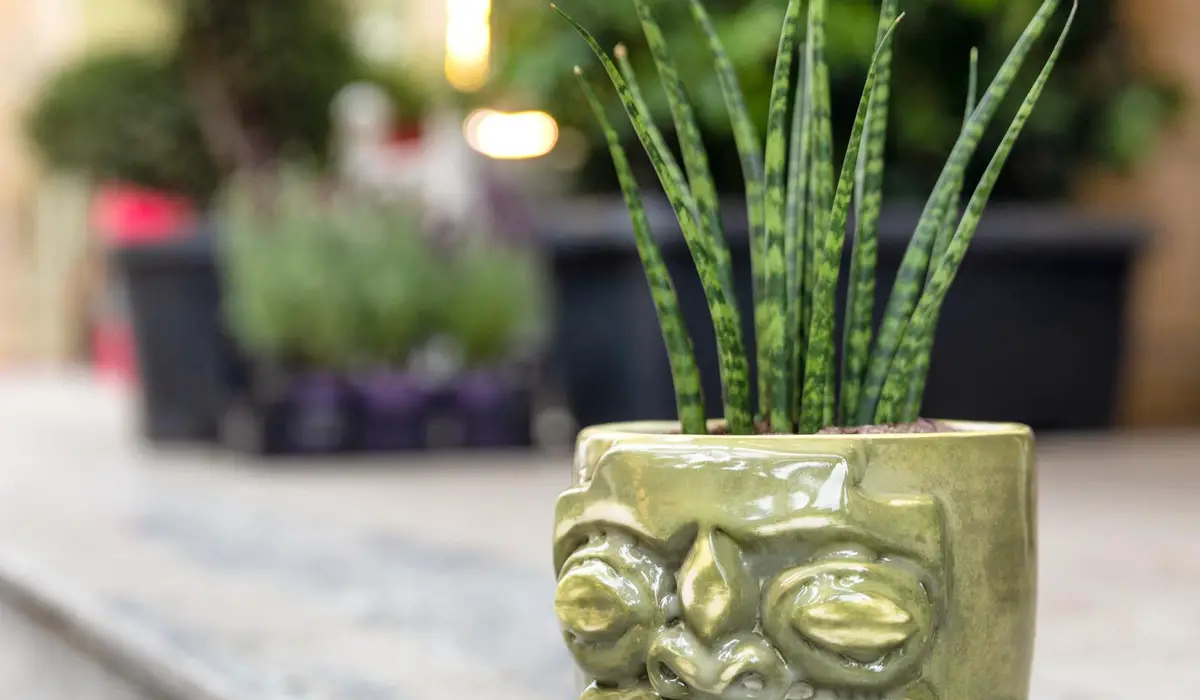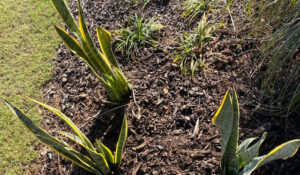Can Snake Plants Live Outdoors?

This post follows our research editorial guidelines.

Growing snake plants outdoors can be a great way to add some greenery to your yard or garden. Plus, your plants can also receive help from pollinators like bees and butterflies when they go through a flowering cycle.
So, can snake plants survive outdoors? The answer is yes, snake plants are very resilient and can tolerate a wide range of conditions. They need warmer temperatures of at least 50 degrees Fahrenheit to thrive. However, there are a few things to keep in mind if you want your plants to thrive.
In this article, I’ll go over what you need to know about growing snake plants outdoors, including the best conditions for growth and plant care.

Table of Contents
Can Snake Plants Survive Outdoors?
Snake plants evolved in the arid, sandy regions of Africa, so you can bet they’re pretty tough plants able to survive in a wide range of conditions outdoors.
Fun fact: Snake plants are so tough that they’re often used for landscaping in difficult-to-grow areas like driveways and parking lots. Thanks to their shallow root system, they don’t need much soil to survive and can even tolerate drought-like conditions.
In terms of temperature, snake plants can tolerate both hot and cold weather. They’ll grow well in USDA hardiness zones 9 through 11, which means they can withstand temperatures as low as 20 degrees Fahrenheit.
However, if you live in an area with extreme temperatures (either very hot or very cold), it’s best to grow your snake plant in a pot so you can bring it indoors when the weather gets too extreme.
So, if you’re thinking about growing snake plants outdoors, know that they can definitely survive in most conditions. However, there are a few things to keep in mind for optimal growth.
Best Conditions for Growing Snake Plants Outdoors
Snake plants are pretty easy to please when it comes to conditions. They prefer well-drained soil and can tolerate a wide range of light levels, from full sun to low light.
In terms of temperature, as I mentioned before, snake plants can tolerate both hot and cold weather. Snake plants can withstand temperatures as high as 90ºF and as low as 55ºF.
When it comes to watering, snake plants are pretty drought-tolerant. They don’t need much water to survive, so you can let the soil dry out completely between watering. In fact, overwatering is one of the biggest mistakes you can make when growing snake plants.
If you do water your snake plants, make sure to do so in the morning, so the leaves have time to dry out before nightfall. This will help prevent fungal diseases like leaf spot.
Best Spot to Plant a Snake Plant Outdoors

Because snake plants are content with pretty much all light types (full sun, partial shade, or even low light), you can plant them just about anywhere in your yard.
If you live in an area with hot summers, it’s best to plant your snake plants in an area that gets some afternoon shade, such as under a tree, window post, etc. This will help protect your plants from the harsh afternoon sun and prevent them from getting too dry.
If you live in an area with cold winters like me, it’s best to plant your snake plants in an area that gets some morning sunlight, or next to a south-facing wall. This will help protect your plants from the cold winter winds. I’d also consider adding a mini plastic greenhouse for added protection from the cold.
You can also place your snake plant on your porch or in your garden. Just make sure to choose an area that gets some filtered sunlight during the day.
Do Snake Plants Go In Full Sun or Partial Shade?
Snake plants can tolerate a wide range of light levels, from full sun to low light. However, they prefer bright, indirect light and will often start to stretch and become dull if they don’t get enough light.
If you live in an area with very hot summers, it’s best to grow your snake plant in partial shade to protect it from the intense heat. Partial shade is also a good option if you want to prevent your snake plant from getting too big. Snake plants can grow quite large (up to 6 feet tall!), so if you want to keep yours on the smaller side, growing it in partial shade will help.
How Do You Take Care of an Outdoor Snake Plant?

Snake plants are a lazy gardener’s dream come true! They’re one of the easiest plants to take care of and don’t require much attention.That said, you shouldn’t completely neglect your snake plant. Here are a few tips for taking care of an outdoor snake plant:
Watering
Earlier, I touched on the fact that snake plants are drought-tolerant. This means that they don’t need to be watered very often. You should only water your snake plant when the soil is completely dry.
One common mistake people make is watering their snake plants too often. This can actually be harmful to the plant and can lead to root rot. Overwatering is the major cause of most snake plant issues.
If you’re not sure when to water your snake plant, it’s always better to be on the side of too little water rather than too much. It’s better for your plant to be a little underwatered than overwatered.You can also check the soil with your finger to see if it’s dry. If the top inch or so of soil is dry, it’s time to water your plant.
Fertilizing
Fertilizing is another area where snake plants are pretty low-maintenance. You’ll rarely need to fertilize your plant and can even get away with skipping it altogether.
If you do want to fertilize your snake plant, you can do so once or twice a year using a balanced fertilizer. I suggest using a slow-release fertilizer that you can just sprinkle on the soil around your plant.
Another option is to use a liquid fertilizer that you can dilute and water your plant with. Just be sure to follow the directions on the package, so you don’t end up harming your plant.
Pruning and Grooming
Pruning and grooming are two more areas where snake plants don’t need much attention. In fact, you can pretty much just leave your plant alone, and it will be happy.
That said, you may want to prune your snake plant every once in a while, to keep it looking its best. You can prune off any yellow or dead leaves, as well as any leggy stems.
If your plant starts to get too big, you can also give it a more drastic pruning. Just cut the plant back to the size you want it, and it will eventually grow back.
Transplanting a Snake Plant Outdoors

Now for the fun part: transplanting your snake plant outdoors!
If you’ve been growing your snake plant indoors, you’ll need to gradually acclimate it to the outdoors.
Start by placing it in a shady spot outside for a few hours each day. After a week or two, you can start increasing the amount of time your plant spends outdoors. Eventually, you can leave it outside all day and night.
When transplanting your snake plant outdoors, choose a spot that gets partial sun to full shade. Snake plants prefer shady spots but can also tolerate full sun if they’re given enough water.
You can either keep your snake plant in the pot it’s in or transplant it to a larger pot or directly into the ground. If you’re planting it in the ground, make sure the soil is well-draining.
Once you’ve chosen a spot, dig a hole that’s twice as wide and just as deep as the pot your plant is in. Gently remove your plant from the pot and place it in the hole. Fill in the hole with soil and water your plant well. You may want to add a layer of mulch around your plant to help retain moisture.
Tips to encourage your snake plant to bloom:
- Provide bright, indirect light. Snake plants that are grown in low-light conditions are less likely to bloom.
- Give your plant a rest. If you’ve been moving your plant around a lot or repotting it frequently, it may not have the chance to rest and won’t bloom.
- Fertilize regularly. Use a fertilizer that’s high in phosphorus to encourage blooming.
Can Snake Plants Survive Winter Outside?

Snake plants are pretty tough and can tolerate a wide range of temperatures. However, they’re not frost-tolerant and will need to be brought indoors or protected if the temperature drops below 50 degrees Fahrenheit.
If you live in an area with cold winters, it’s best to bring your snake plant indoors for the winter. Just pot it up and place it in a sunny spot near a window.
You can also wrap your plant in burlap or frost cloth to help protect it from the cold. Just be sure to bring it indoors if the temperature is going to drop below freezing.
Will a Snake Plant Bloom Outdoors?
Many plant parents don’t realize that snake plants can actually bloom. While they’re not known for their flowers, they can produce small, white blossoms that smell sweet.
Snake plants typically bloom in the spring or summer, but they can also bloom at other times of the year if they’re grown in the right conditions.
Here are some tips to encourage your snake plant to bloom:.
With a little patience and care, you can enjoy the sweet-smelling flowers of your snake plant. Just be warned that the blooms don’t last long!
Final Thoughts
While snake plants can survive outdoors, they’re typically grown as houseplants. They prefer shady spots and will do best if they’re protected from direct sunlight.
However, if you prefer to keep your snake plant outdoors, just be sure to give it plenty of water and protection from the cold. With a little care, you can enjoy this tough and unique plant in your garden for years to come.
